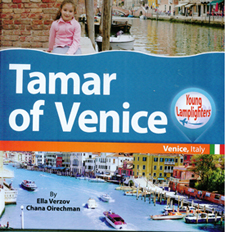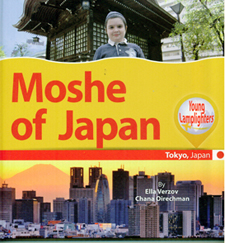Ella Verzov and Chana Oirechman, Tamar of Venice (c) 2013, Menucha Publishers, Brooklyn, ISBN 978161465170-3, 54 pages. And, Ella Verzov and Chana Oirechman, Moshe of Japan, (c) 2013, Menucha Publishers, Brooklyn; ISBN 978161465171-0, 50 pages
By Donald H. Harrison

SAN DIEGO–Chabad has come up with a charming, multi-purpose idea for a children’s book series. Authors Ella Verzov and Chana Oirechman, working with local photographers, peer into the lives of the elementary-school-aged children of the shlichim, the emissaries that the Lubavitchers send around the world to spread Yiddishkeit.
The first two books in what may become an inspirational multi-volume series are Tamar of Venice and Moshe of Japan.
Tamar Rieber tells us of her excitement about living in a city where there are no streets for cars, only canals for boats. If she were to drop something out of her window, it would go ker-plunk. Her second favorite day is Wednesday when she and her family go shopping for her favorite day, which of course is Shabbat. To shop the family goes to the Pescheria--the fish market–where they pick out kosher fish, which have fins and scales..
Her home is in the Jewish ghetto of Venice, which she explains is the oldest ghetto in the world. In fact, the word “ghetto” comes from here, because the first city to require Jews to live in a special place was Venice. “Ghetto” was the area where a foundry was located. Today Jews live all over the city, but the ghetto boasts a synagogue, a kosher restaurant, and other indications of revived Jewish life.
The motto of San Diego Jewish World is that “there is a Jewish story everywhere” and Chabad certainly helps to demonstrate that with this Lamplighter book series.
Moshe Sudakevich, living in Tokyo, uses the Internet to go to school. His classmates are Chabad children around the world. Because of global time differences, class time for him is in the evening, while for most of the other children it is during the day. On Fridays he can’t even “attend” the Internet school because Erev Shabbat already has come, even before class has started.
Among Moshe’s favorite weekday activities is playing at “Children’s Palace,” where he learns from Japanese instructors various phrases like “ohayoo gozaimasu” meaning “good morning” and “konnichiwa” for good afternoon. Sometimes he makes a mistake and says “konbanwa” (good evening) when he means “konnichiwa.” Another favorite place in Tokyo is Kidzania, a model city where children can practice working at any job that appeals to them ranging from firefighter to doctor.
Moshe’s father tells him shlichim are a bit like firefighters. “We came all the way to Tokyo to help Jews. We must be ready to help at all hours.”
Both books have basic glossaries with simple phrases respectively in Italian and Japanese, sets of interesting facts about their respective cities (Venice and Tokyo), and a map of the world showing exactly where the cities are.
So, by reading these stories, American children will 1) learn a little about foreign cities; 2) learn about how one can be an observant Jew, even in places where Jews are in a decided minority, 3) become more acquainted with the work and lifestyle of Chabad emissaries–as seen through the eyes of their children, and 4) keep Israel in mind–as both Tamar and Moshe find themselves often thinking about the Jewish homeland.
*
Donald Harrison is editor of San Diego Jewish World. He may be contacted via donald.harrison@sdjewishworld.com


Pingback: Seeing the World from a Jewish Child’s Perspective | Crown Heights Daily News » Local Crown Heights News and Exclusive News Worldwide